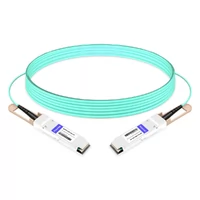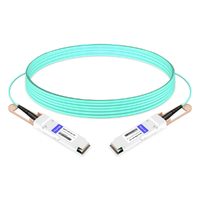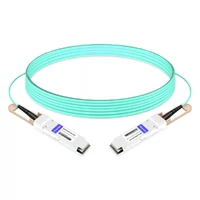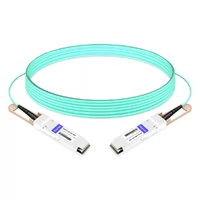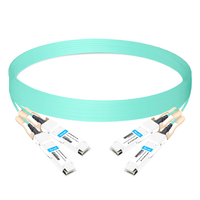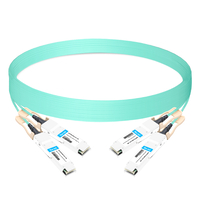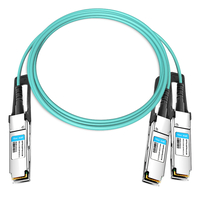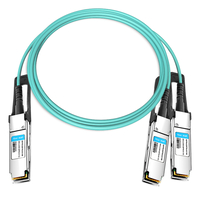200G QSFP56 AOC and 200G QSFP56 Breakout AOC are two types of active optical cables that can be used for high-speed data center connectivity. They both have a QSFP56 form factor, which means they have four channels of 50Gbps each, but they use different modulation schemes and have different applications.
200G QSFP56 AOC uses PAM4 modulation, which means it encodes two bits per symbol, resulting in a higher data rate per channel. It is compatible with 200G Ethernet and InfiniBand HDR standards, and can support distances up to 30 meters. It is ideal for short-reach interconnects between switches, servers, and storage devices.
200G QSFP56 AOC is compatible with 200G Ethernet and InfiniBand HDR standards, which are protocols that define how data is transmitted and received over a network. 200G Ethernet is a standard that supports data rates of up to 200 gigabits per second (Gbps) over a single optical fiber or copper cable. InfiniBand HDR is a standard that supports data rates of up to 200 Gbps over a single lane or up to 800 Gbps over four lanes of a parallel optical cable. Both standards use PAM4 modulation to achieve higher bandwidth and efficiency.
200G QSFP56 AOC can support distances up to 30 meters, which is suitable for short-reach interconnects between switches, servers, and storage devices in a data center. It has low power consumption and high reliability, making it an ideal choice for high-performance computing and cloud applications.
200G QSFP56 Breakout AOC is a special type of AOC that splits the four channels of the QSFP56 into two pairs of 100G channels, each with a QSFP28 connector. It uses NRZ modulation, which means it encodes one bit per symbol, resulting in a lower data rate per channel. It is compatible with 100G Ethernet and InfiniBand EDR standards, and can support distances up to 100 meters. It is ideal for connecting legacy devices that use QSFP28 ports to newer devices that use QSFP56 ports.
200G QSFP56 Breakout AOC is compatible with 100G Ethernet and InfiniBand EDR standards, which are protocols that define how data is transmitted and received over a network. 100G Ethernet is a standard that supports data rates of up to 100 Gbps over a single optical fiber or copper cable. InfiniBand EDR is a standard that supports data rates of up to 100 Gbps over a single lane or up to 400 Gbps over four lanes of a parallel optical cable. Both standards use NRZ modulation to achieve lower latency and higher compatibility.
200G QSFP56 Breakout AOC can support distances up to 100 meters, which is suitable for connecting legacy devices that use QSFP28 ports to newer devices that use QSFP56 ports in a data center. It has high flexibility and scalability, making it an ideal choice for upgrading and expanding your network infrastructure.
To use these products, you need to connect the QSFP56 connectors to the corresponding ports on your devices, and make sure they are properly aligned and locked. You also need to configure the devices to recognize the cable type and speed, and check the link status and performance.
Related Products:
-
 QSFP56-200G-AOC-3M 3m (10ft) 200G QSFP56 to QSFP56 Active Optical Cable
$350.00
QSFP56-200G-AOC-3M 3m (10ft) 200G QSFP56 to QSFP56 Active Optical Cable
$350.00
-
 QSFP56-200G-AOC-10M 10m (33ft) 200G QSFP56 to QSFP56 Active Optical Cable
$365.00
QSFP56-200G-AOC-10M 10m (33ft) 200G QSFP56 to QSFP56 Active Optical Cable
$365.00
-
 QSFP56-200G-AOC-50M 50m (164ft) 200G QSFP56 to QSFP56 Active Optical Cable
$415.00
QSFP56-200G-AOC-50M 50m (164ft) 200G QSFP56 to QSFP56 Active Optical Cable
$415.00
-
 QSFP56-200G-AOC-100M 100m (328ft) 200G QSFP56 to QSFP56 Active Optical Cable
$465.00
QSFP56-200G-AOC-100M 100m (328ft) 200G QSFP56 to QSFP56 Active Optical Cable
$465.00
-
 2QSFP56-200G-AOC-5M 5m (16ft) 2x200G QSFP56 to 2x200G QSFP56 PAM4 Breakout Active Optical Cable
$805.00
2QSFP56-200G-AOC-5M 5m (16ft) 2x200G QSFP56 to 2x200G QSFP56 PAM4 Breakout Active Optical Cable
$805.00
-
 2QSFP56-200G-AOC-15M 15m (49ft) 2x200G QSFP56 to 2x200G QSFP56 PAM4 Breakout Active Optical Cable
$830.00
2QSFP56-200G-AOC-15M 15m (49ft) 2x200G QSFP56 to 2x200G QSFP56 PAM4 Breakout Active Optical Cable
$830.00
-
 QSFP56-2QSFP56-AOC3M 3m (10ft) 200G QSFP56 to 2x100G QSFP56 PAM4 Breakout Active Optical Cable
$480.00
QSFP56-2QSFP56-AOC3M 3m (10ft) 200G QSFP56 to 2x100G QSFP56 PAM4 Breakout Active Optical Cable
$480.00
-
 QSFP56-2QSFP56-AOC10M 10m (33ft) 200G QSFP56 to 2x100G QSFP56 PAM4 Breakout Active Optical Cable
$495.00
QSFP56-2QSFP56-AOC10M 10m (33ft) 200G QSFP56 to 2x100G QSFP56 PAM4 Breakout Active Optical Cable
$495.00

